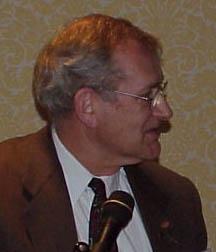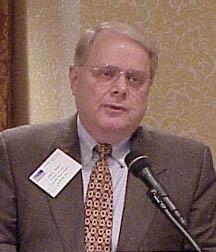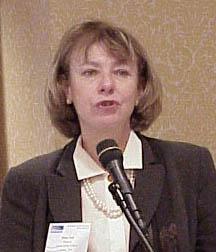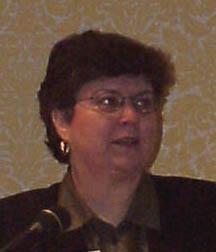
March - April 2000
|
WIN Calls For Federal Infrastructure Assistance The nation's 54,000 drinking water systems and 16,000 wastewater systems face staggering infrastructure funding needs of nearly $1 trillion over the next 20 years and a shortfall of a half of a trillion dollars, according to Clean and Safe Water for the 21st Century - a report released on April 12 by the Water Infrastructure Network (WIN). To view the report, see e-briefs at www.amwa-water.org. Commenting on the needs that drinking water systems face, AMWA President Buddy Williams, Director of the Nashville Department of Water and Sewerage Services, noted that "many water treatment plants will need major refurbishment or replacement in the years to come if we expect to continue providing safe drinking water to our communities." |
To help find federal solutions to infrastructure needs, four Congressional leaders have established the Water Infrastructure Caucus. From left to right are caucus chairs Reps. Michael Bilirakis (R-Fla.), Sherrod Brown (D-Ohio), Sherwood Boehlert (R-N.Y.), and Robert Borski (D-Pa.). |
"Local governments and ratepayers must fund 90 percent of water infrastructure costs while grappling with competing needs to educate children, maintain roads and transportation systems, fight crime, and provide social services," says WIN. "Better solutions are needed."
According to WIN, there are a number of possible solutions. These include grants, trust funds, loans, and incentives for private investment. "So, the question is not whether the federal government should take more responsibility for drinking water and wastewater improvements, but how."
WIN is comprised of two dozen groups representing water agencies, local elected officials, state administrators, and engineering and equipment companies.
Congressional, Agency Leaders Place Focus On EPA Oversight, Source Water Protection
EPA is one of the few agencies that doesn't have to defend its budget, said Environment and Public Works Committee Chairman Robert C. Smith (R-N.H.) at AMWA's recent 2000 Legislative and Regulatory Conference.
In his tenure as chairman of the Committee, Smith will put more emphasis on EPA oversight and promote the use of sound science in Agency rulemakings, he told AMWA members.
|
|
|
|
|
|
Chuck Fox, EPA's Assistant Administrator for Water, also spoke at the conference. His comments centered on reducing nonpoint source pollution, and he encouraged AMWA members to support the Agency's TMDL proposal. However, since Fox's appearance, he has pledged to Congressional leaders to remove certain controversial provisions, including language that would have protected drinking water sources better than current law does.
Fox also noted that funding is up in EPA's Fiscal Year 2001 budget for several source water protection efforts, and he emphasized the need to better control animal feeding operations and find affordable technologies to help control this source of pollution.
Other speakers included Rep. Sherwood Boehlert (R-N.Y.), who pledged to seek ways to reduce nonpoint source pollution and find ways to help water systems finance drinking water infrastructure needs; Rep. James Walsh (R-N.Y.), who has made drinking water research one of his top priorities as chair of the House Appropriations subcommittee with jurisdiction over EPA's budget; and Sen. Blanche Lincoln (D-Ark.), who echoed Smith's concerns about the proposed TMDL rule.
AMWA Members Are Making Waves
AMWA's Legislative and Regulatory Conference was the stage for Making Waves II, a session on innovative practices. Presentations made during the session will be compiled into a publication with the same title.
One of the presenters was John Sullivan, Chief Engineer for the Boston Water and Sewer Commission. Sullivan focused on understanding the role that technology and information systems play in making competitive public utilities, and he recommended that his colleagues benchmark with other local utilities, such as gas and electric, to compare how they have integrated information technology and how it benefits services.
The ownership, governance, and organizational structure of the Louisville Water Company was the topic of another Making Waves presentation. The utility is set up as an investor-owned company, but the City of Louisville is the sole stockholder. Under this unique "municipal corporation" structure, the city earns a return on equity and the utility functions as a business.
Since it is municipally owned, the company does not pay taxes and can raise capitol using tax exempt bonds. Rates are set and approved by the seven-member Board of Water Works, on which the Mayor serves ex officio and the company president serves as the non-voting chairman. The company operates throughout the region (including several nearby counties) and has one rate structure (cost-of-service ratemaking is used). John Huber, President and CEO of the Louisville Water Company, told AMWA members, "The single most valuable attribute is the freedom to act and adapt to changing needs."
|
|
|
|
|
|
|
|
|
|
Douglas MacDonald, Executive Director of the Massachusetts Water Resources Authority (MWRA), discussed the need for public water systems to reach out to local public health officials to ensure their understanding and cooperation in the delivery of information to the public. The relationships built over time through communication and trust will be rewarded in the long run and particularly at very critical times, he said.
After a very successful collaboration with health officials on lead and Cryptosporidium concerns, MWRA formally established its Health Advisory Group. The group provides guidance both on courses of action and on effective consumer messages. MWRA also has involved the group in disinfection issues and has enlisted members' participation in planning for a new $260 million treatment facility.
Seattle Public Utilities Managing Director Diana Gale focused on how her agency manages its compliance with the Endangered Species Act. Seattle's vast watershed is home to many species, and the Act is administered by a handful of federal agencies. These realities make maneuvering through the complexities of the Act cumbersome and dangerous.
Making Waves II will be published this spring.
Need Funding For Your Watershed Project? Look Here Sixty-nine individual funding sources for watershed protection
projects are detailed in the latest edition of EPA's Catalog of
Federal Funding Sources for Watershed Protection. The catalog
contains a one page fact sheet on each funding source complete with
the types of projects funded, eligibility requirements, and contact
information. Funding sources range from EPA's Wetlands Program
Development Grants and Watershed Assistance Grants to the Department
of Agriculture's Watershed Protection and Flood Prevention
Program. The catalog also lists private, nonprofit sources for both
financial and technical assistance, adding greatly to its usefulness
as a resource. A short description of the private sources is given
along with Internet links where available. For example, one source
listed, the Council of Philanthropy, maintains a web site that lists
grant announcements and also has a searchable database where users
can find which funders have provided funding for projects similar to
theirs in the past. The catalog can be found on the Internet at:
www.epa.gov/owow/watershed.
Minneapolis, St. Paul Take Different Approaches To A Common Objective
Regulatory answers to problems often follow a one-size-fits-all approach. But utilities have argued that solutions tend to be site specific. Such is the case in St. Paul and Minneapolis, where two systems drawing from a common source of water are pursuing vastly different approaches to providing high quality water to their consumers, while educating and involving consumers in the process.
With EPA considering a variety of regulatory scenarios for Stage 2 of the Microbial and Disinfection Byproduct Rules, the approaches being taken by AMWA members St. Paul and Minneapolis offer two viable alternatives.
"Our future is in ultrafiltration," reported Adam Kramer, Director of the Minneapolis Water Works. The ultrafiltration approach was selected after an evaluation of risks, particularly those of Cryptosporidium, from their Upper Mississippi River source. The decision involved extensive citizen participation in evaluating both risks and options to meet future regulations. The approach also solves ongoing challenges of an aging plant infrastructure.
 |
 |
"Our answer is watershed protection," said Bernie Bullert, General Manager of the St. Paul Water Utility. St. Paul draws on the same Upper Mississippi River but has the good fortune to do so through a series of reservoirs, each with its own watershed, Bullert told his colleagues. |
|
Adam Kramer |
|
The reservoir systems provide residence time, which both improves water quality prior to treatment and allows sufficient storage so that it is not necessary to pump from the river when it has water quality problems. This, combined with extensive watershed controls, allows greatly improved microbial and chemical water quality prior to treatment and produces high customer satisfaction.
Is UV Ready For Prime Time?
Recent discussions among members of the Federal Advisory Committee (FACA) negotiating the Stage-2 Microbial and Disinfection Byproducts Rules have focused on disinfection of Cryptosporidium in drinking water by ultraviolet radiation (UV). Although the technology is presently little used in the United States for drinking water, its use is increasing for wastewater disinfection. Because it is relatively inexpensive compared to other technologies for dealing with Cryptosporidium, many FACA members view it as a potential "silver bullet" as part of the Stage-2 answer.
|
|
Dr. Dan Schmelling, EPA's expert on UV issues, briefed AMWA members on the pros and cons of UV, as shown on the accompanying table, at the 2000 Legislative and Regulatory Conference. He noted that UV is used in over 1,000 public water systems in the United States, but the systems tend to be small, noncommunity groundwater systems. UV use in Europe exceeds 1,500 drinking water plants, again with the majority being small, although sizes up to 80 MGD exist. Wastewater use in the U.S. includes more than 500 installations with sizes up to 225 MGD. |
|
Advantages of UV Disinfection No disinfection by-products |
Disadvantages of UV Disinfection No residual disinfectant |
|
|
|
|
|
|
|
|
|
|
|
|
|
Speaking at AMWA's Legislative and Regulatory Conference were David Conover, Majority Staff Director of the Senate Environment and Public Works Committee (not pictured); Frank Cushing, Majority Staff Director of the House Appropriations Subcommittee on VA, HUD and Independent Agencies, which oversees EPA's budget; and House Resources Committee Majority Chief Counsel Elizabeth Megginson. Conover discussed increased oversight of EPA's water programs, and Megginson described H.R. 3160, a bill to reauthorize and reform the Endangered Species Act. Cushing addressed EPA spending issues. EPA Office of Ground Water and Drinking Water Director Cynthia Dougherty and Branch Chief Ephraim King updated AMWA members at the conference on the development of future drinking water rule. Ken Rubin, a partner with the law firm of Morgan, Lewis & Bockius, discussed a wide range of legal issues facing municipal water suppliers, including the Department of Justice's case against the Massachusetts Water Resources Authority and toxic tort suits against suppliers in California. |
Associations Gear Up For New Competitiveness, Business Services Workshops
AMWA and the Association of Metropolitan Sewerage Agencies (AMSA) announced recently the availability of two workshop choices to think, get and stay competitive and to create high performance business services.
Utilities can now sign up for an on-site customized Thinking, Getting and Staying Competitive Workshop. This new workshop is ideal for initiating competitiveness programs and reenergizing or refocusing existing ones. Based on participant comments and experience from previous workshops, this next generation is updated and improved to better serve publicly owned water and wastewater utilities. This workshop provides utilities with the tools to identify opportunities for change and to develop strategies to make competitiveness part of a utility's culture. What's more, instructors tailor the workshop based on organizational and financial information provided by the host utility.
Creating High Performance Business Services is the newest workshop offered by AMWA and AMSA. The workshop recognizes that public utilities are facing major changes in how they operate and provide services. Adapting to change means being competitive, and Creating High Performance Business Services can significantly enhance the performance of business services by including them in a utility's competitiveness objectives.
This workshop is a hands-on, utility-wide approach for improving the delivery of utility business services such as procurement, engineering, human resources, accounting and finance, information management, fleet management, and customer service. The workshop also demonstrates why providers of these services must work hand-in-hand with core O&M staff to build a high-performance, world-class organization.
To maximize utility resources, AMWA and AMSA recommend neighboring utilities schedule a business services workshop jointly.
To schedule one at your location or for more information, contact AMWA at (202) 331-2820 or visit AMWA's website at www.amwa-water.org.
Azurix (www.azurix.com) - Parent Enron
seeking to unload Azurix. Recently closed its European offices and
initiated third round of layoffs. Azurix owns Wessex Water (UK) and
Philips Utilities Management, an O&M contractor. Expanded
web-based marketing on its Water2Water.com site to offer water
treatment equipment, services and chemicals in addition to its
established purpose of trading water and water
rights. American States Water Company
(www.aswater.com) - Reportedly on the auction block. Recently agreed
to acquire Chaparral City Water Company in Arizona for $31.2
million. Parent of Southern California Water Company, O&M
service provider American States Utility Services, and a power
company. American Water Works Company
(www.amwater.com) - Recently formed American Water Services Inc.
after paying $30 million to buy out Anglian Water's shares of
O&M contractor American-Anglian. Undertook $2 billion in
acquisitions last year. Primary focus is ownership of utilities,
including San Jose Water Corp., Citizens Utilities, National
Enterprises Inc., and several former United Water
utilities. California Water Service Group
(www.calwater.com) - Parent of Cal Water, Washington Water Service
Co., and CWS Utility Services, its O&M division. The company
also sells electricity. Approval from the California PUC for the
$63.5 million purchase of neighboring water utility Dominquez
Services Corp., expected in early April, was postponed until later
in the second quarter. Indianapolis Water Company
(www.iwcr.com) - Provides water to the City of Indianapolis. Parent
company NiSource also owns electric and natural gas utilities.
Seeking O&M contracts. Kelda Group (UK) (www.keldagroup.com)
- Bought Aquarion Company (www.aquarion.com), the parent of BHC and
Aquarion Management Services, its O&M division.
Philadelphia Suburban Corp.
(www.suburbanwater.com) - The third largest investor-owned drinking
water company in U.S., Philadelphia Suburban is in the midst of an
aggressive acquisition spree, focusing mainly on small systems.
Recently agreed to purchase its first wastewater company. Acquired
Consumers Water last year. Vivendi (FR) owns 18% of Philadelphia
Suburban. Suez Lyonnaise des Eaux (FR) (FR)
(www.suez-lyonnaise-eaux.com) - Announced it will acquire all
remaining common shares of United Water (www.unitedwater.com), the
second largest owner and operator in U.S, and an aggressive
competitor of O&M contracts (the transaction values all issued
common shares at $1.36 billion). Recently merged all water
activities (Lyonnaise des Eaux, Nalco and Degremont).
Thames Water (UK)
(www.thames-water.com) - The largest owner and operator in the UK,
Thames is acquiring New Jersey-based E'Town Corp.
(www.etownwater.com) which owns Elizabethtown Water Co. and Mt.
Holly Water Co. Signed strategic alliance with Operations Management
International, Inc. (OMI) to pursue O&M business in the U.S. and
Canada. Vivendi Water (FR) (www.vivendi.com) -
Announced major alliance with Vodafone (UK) to focus on
telecommunications. Likely to spin off water division this year,
analysts predict. Is the parent of O&M contractor U.S. Filter
(www.usfilter.com) and Culligan (home filters and bottled water).
Owns 18 percent of Philadelphia Suburban. U.S. Filter absorbed
Professional Service Group (PSG) in 1999 and is the leading producer
of water treatment equipment. Vivendi recently spun off
Massachusetts-based environmental engineering consulting firm
Metcalf & Eddy, which was once a part of Aqua Alliance along
with PSG.
Privatization Notes
United Water: We Need More Enforcement
Speaking to a subgroup of EPA's Financial Advisory Board (EFAB) recently, a United Water officer recommended increased enforcement against public water agencies by EPA. "We need more of it," he said, because it encourages mayors to consider privatization. The comments by John Joyner, United Water's Vice President for Business Development for North America, were made in the context of the unexpectedly small market for privatization and O&M contracts that has developed.
Joyner stated that the private water companies overestimated the success they would have in signing O&M contracts with municipal water suppliers. He also noted to EFAB that private companies did not anticipate the level of resistance to privatization that the market has witnessed. He said United Water was less successful than the company had planned because municipal utilities reacted quickly to seek operating improvements. "The anti-privatization sentiment is stronger than we anticipated," he said, "so there are not as many deals going forward."
Joyner also noted that United Water was surprised by those engineering firms standing "shoulder-to-shoulder" with their public sector clients, and suggested that this was a conflict of interest.
Mayors' Council Promotes Privatization; Private Companies Serve As Key Advisors
In its 1999 Activities Report, the U.S. Conference of Mayors' Urban Water Council (USCM-UWC) cited progress in its efforts to increase competition and improve cost efficiencies in water and wastewater systems through public/private partnerships.
Among its highlighted achievements, the UWC cited the inclusion of water and wastewater infrastructure public/private partnerships among the top ten issues of incoming USCM president, Mayor Wellington Webb of Denver. A major goal of the Mayors is to seek tax incentives to advance privatization. See the adjacent list of mayors who have joined the UWC.
To help the Mayors reach their goal, several private sector interests, listed below, are serving as advisors. According to the UWC, the team of advisors does not include any municipal water agency executives.
Co-chairs Patrick J. McManus, Lynn Members Clarence Anthony, South Bay Angel Malave, Cidra American Water Works Co., Inc.
U. S.
Conference of Mayors
James H. Sills, Jr.,
Wilmington
Jose Aponte,
Carolina
Victor Ashe, Knoxville
H. Richard Borer, Jr., West
Haven
Sam Kathryn Campana, Scottsdale
Bill Campbell,
Atlanta
John DeStefano, New Haven
Patricia Dowling,
Lawrence
Gene Eriquez, Danbury
Carleton Finkbeiner,
Toledo
Frank Fry, Westminster
Joseph P. Ganim,
Bridgeport
Jerry Johnson, North Chicago
Scott King,
Gary
Glenn Lewis, Moore
Patrick McCrory,
Charlotte
James Mears, Franklin
George Miller,
Tucson
Robert Minsky, Port St. Lucie
Marc Morial, New
Orleans
Rita Mullins, Palatine
Rick Mystrom,
Anchorage
Robert Nunes, Taunton
Meyera E. Oberndorf, Va.
Beach
Donald Plusquellic, Akron
Gary Podesto, Stockton
M.
Susan Savage, Tulsa
Bill Souder, Hurst
Thomas Suozzi, Glen
Cove
Bruce Tobey, Gloucester
Michael Traficante,
Cranston
Don Trotter, Clarkesville
Joan
Wagnon,Topeka
Wellington Webb, Denver
Aqua Alliance,
Inc.
Camp Dresser & McKee
CH2M Hill
Hawkins Delafield
& Wood
HDR Engineering, Inc.
Investor Owned Water
Utilities Group
Lehman Brothers
Malcolm Pirnie, Inc.
Ogden
Water Company
Piper & Marbury
Poseidon Resources
Corporation
R.W. Beck and Associates
Severn Trent
Environmental Services, Inc.
U.S. Filter Operating Services,
Inc.
U.S. Water L.L.C.
United Water
Verner, Liipfert,
Bernhard, McPherson & Hand PC
Wheelabrator Technologies Inc.
BioGro Division
Legislative Update
Appropriations. AMWA's Mike Hooker, Executive Director of the Onondaga County Water Authority in New York testified on EPA's budget on April 12, asking for $1 billion for the drinking water loan fund, $100 million for clean-up of MTBE contaminated supplies, and $49 million for drinking water research. House and Senate bills are expected in May or June.
MTBE. The Senate and House will likely act before the end of this session to pass legislation to phase out MTBE and clean up contaminated supplies. Legislation would probably fund development of treatment technology. Several bills have been introduced.
Plumbing Standards. A bill proposing to eliminate water efficiency standards for plumbing fixtures was narrowly defeated April 12 by the House Subcommittee on Energy and Power.
Infrastructure. The House of Representatives established the Water Infrastructure Caucus in April to seek ways to fund an infrastructure gap amounting to nearly $500 billion over the next 20 years. EPA proposed granting $825 million and $800 million to states for the drinking and clean water loan programs, respectively.
Superfund. Reauthorization and reform of Superfund remains a high priority for House and Senate committee leaders. Two bills in the House are ready for a floor vote.
WRDA. Public works committees in the House and Senate are gearing up to introduce legislation authorizing funding for water projects.
Endangered Species Act. The chair of the House Resources Committee plans to win House passage of his bill to reauthorize and reform the Endangered Species Act. Among the provisions of the bill, H.R. 3160, is one that protects non-federal activities that address public health and safety. These include ongoing maintenance, routine operation, and emergency repair of existing infrastructure.
Utility Takeovers. Late last year, the American Water Works Company persuaded Rep. Phil Crane (R-Ill.) to introduce a bill outlawing the use of tax-except financing to purchase water utilities through eminent domain. Crane's H.R. 3309 is aimed at deterring "unwarranted hostile takeovers of water utilities." The House has taken no action on it.
Regulatory Update
Radionuclides Rule. The Radionuclides Rule Notice of Data Availability (NODA) could appear in the Federal Register this month. The Safe Drinking Water Act mandates a November 2000 deadline for the final Radionuclides Rule.
Filter Backwash Rule. The proposed Filter Backwash Rule was published in April. Comments are due to EPA by June 9. EPA's deadline for finalization is August 2000.
Arsenic Rule. The proposed Arsenic Rule remains in the White House Office of Management and Budget (OMB) for review. It will likely be proposed in June. The rule must be finalized by January 2001, according to the Safe Drinking Water Act.
Public Notification Rule. EPA published the final Public Notification Rule in April. The Public Notification Handbook is soon to follow.
Ground Water Rule. Vice President Gore announced the proposal of the Ground Water Rule on April 17. It is not expected to significantly affect large ground water systems that currently disinfect.
Stage 2 M/DBP Rules. The federal advisory
committee negotiations on the Stage-2 DBP and microbial rules are
continuing on a monthly basis through June. Committee members are weighing
various regulatory scenarios.















